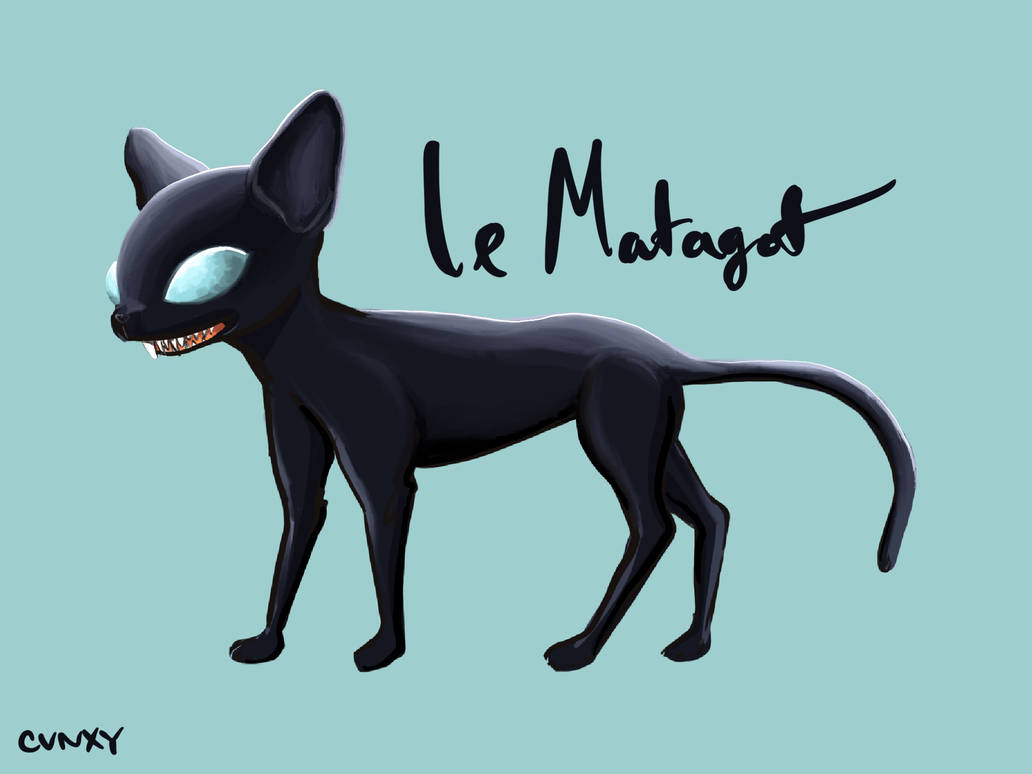Announcements
Welcome to Care of Magical Creatures!
Welcome to Care of Magical Creatures! This is the final year of the course. You can find the first year of the course here. Below you can find links to textbooks, additional pages you may find of interest, and details about when and why the course was last updated.
The Care of Magical Creatures Companion Guide
Care of Magical Creatures Facebook Page
Many artistic depictions of creatures used in this course were created by the DeviantArt user maryquiZe. We recommend checking out her work!
Course Last Updated: November 2021 for Broken Image Fixes and Grammar Corrections
Announcements Last Updated: October 2021
Lesson 2) Chat Noir Chanceux
Chat Noir Chanceux
Welcome back to Care of Magical Creatures. Today we are going to discuss a French creature that many of you have likely heard whispers about, but may not have believed actually existed. You may have only heard the Muggle folklore about this creature, if you’re Muggle-born. We are putting all of that to rest, because today we will be covering the matagot.
Matagots: The Multiplying Shapeshifters
 Introduction and Physical Description
Introduction and Physical Description
Matagots are magical creatures that take the form of a black, cat-like animal with glowing blue eyes. This is the form you will likely see them in. However, these creatures do take a “spirit” form. Matagots are spirits that commonly take the form of the black cats we see them as. However, when leaving any all-magical areas, they turn into regular cats. Try to think of them like kelpies. Kelpies are shape shifters, changing between forms like horses and sea serpents. Matagots shift between the skeletal black cat form we see (which I will call their magical form), regular cats, and their spirit form. However, please keep in mind that kelpies are not spirits, so don’t create that association, or Professor Penrose might come knocking on the door of my hut.
Though these creatures take a spirit form, they are not to be confused with familiars, which is defined as an animal companion that is very similar to an individual, causing them to be linked in a spiritual way. You may also occasionally hear the term “spirit familiars” used, which is another way of saying a creature is a familiar. Despite his knowledge in the area, even Newt Scamander was known to accidentally use this term to describe matagots, until it was determined in the late 1950s that true familiars don’t exist. As most of you should know, there are no true familiars in the wizarding world. There may be groups of creatures or individual creatures that prefer certain people over others because of emotional attachment, but these are not true familiars. People often call matagots familiars because they do take a spirit form and they seem to only cooperate with individuals of the French Ministry. However, it’s not a single person at the French Ministry they are attracted to; they are attracted to French culture. Familiars are typically drawn to one individual because they are similar in personality, and are often linked together spiritually. In Muggle lore, familiars even help witches and wizards perform magic. Matagots are not helping the French perform magic; they are being used as a form of security.
History and Folklore
Wizarding World
Matagots were initially discovered in the early 1800s, though this date is often disputed because many believe that there were individuals who already knew about the existence of matagots but simply kept it to themselves. When we discuss their abilities later on in the lesson, you will understand why someone might want to keep their existence a secret.
The French population as a whole stumbled upon matagots by accident, really. Sometime around 1810, French wizards noticed that some cats seemed a bit odder than others. History’s words, not mine. To me, cats are pretty odd as a whole, but the cats observed by these citizens were odd because of their attraction to specific individuals. They clung to wizards, following them around the city. It wasn’t until one unnamed wizard let them into his home that their alternate form was revealed. When word of this spread, witches and wizards around the city began bringing any cat they found into their homes, hoping they would find their own matagot. Even after their “discovery,” it took another decade for the French to officially classify them as creatures, and to collect all known matagots for Ministry use.
The decision that matagots could only be used by the Ministry was not a difficult one, according to the documentation provided. After discovering their multitude of abilities, the Ministry felt the matagot was a creature best owned by individuals that could handle their skills and demeanor. This is especially true because of the danger matagots can pose should they feel threatened.
Once the decision was made, matagots were exclusively used by the French Ministry. When we consider that the French Ministry was founded in 1790, and the discovery of matagots was made in the early 1800s, this means that matagots have been a part of the French Ministry for nearly its entire history. On occasion, a matagot has been found in the home of a wizard, particularly throughout the late 1800s and into the 1900s. This might not be intentional: the wizard may just think they are taking in a stray cat. When this happens, the individual is fined and their name put into a database, which means they regularly undergo surprise inspections to ensure there are no repeat offenses. The matagot in question is taken by the Ministry and added to their clowder, a term used to describe a group of felines.
Muggle
In French Muggle folklore, stories of the matagot, also commonly called a mandagot, have been passed around for several centuries. The most basic common thread is that a matagot is a spirit that often takes the form of a black cat.. Muggles believe this cat associates with witches and sorcerers, bringing them good fortune. In some regions of France it is even referred to as the “money cat” because of this belief. It is also considered a bringer of good fortune because if a family feeds the cat well, it will bring them wealth. One story in particular states that if the matagot is allowed to eat first at every meal, the family will be rewarded with a solid gold coin.
While some stories discuss the wealth a matagot can bring you, others discuss how evil the creature is. Because of the matagots ability to shift between multiple forms, the creature is also seen as a harbinger of evil in Muggle lore. It is also thought that you should never look at one. This often is linked to the superstition that many societies have about black cats. As many of you may know, many individuals believe a black cat walking across your path dooms you to a life of bad luck. Many early settlers of the Americas also believed that black cats were witches in disguise. It is extremely likely that the stigma associated with black cats as a whole is a significant part of the stigma matagots face from Muggles, simply because that’s the form they are associated with.
This stigma may also stem from them having a similar appearance to the Sphynx cat (which should not be confused with the sphinx we know, which is not nearly as adorable as this cat), a breed of cat known for its lack of hair and skeletal appearance. This type of cat was developed through selective breeding for a recessive mutation of cats in the 1960s, and is now considered a separate breed. Many people find these cats unattractive because of their bony appearance and lack of hair. When you look at matagots in their magical form, they do bear a resemblance to these cats. I have provided a picture below for you to compare the appearance of the two.

Because many people find these cats unattractive or unnatural, that stigma has carried over into their view of matagots, not just in the Muggle world but with wizards who are familiar with Sphynx cats as well. This has caused many Muggle-borns to believe that the French were magically altering Sphynx cats to use as protection, which as we all know from our discussion of legislation in Year Five, would be illegal. Once they are told this is not the case, they are still rather cagey about the creatures, citing their similarity in appearance to Sphynx cats and the stigma those cats face as their reasoning.
Diet and Reproduction
Matagots are carnivorous creatures, hunting down birds while in cat form. The French Ministry feeds their matagots a variety of wild birds and even chickens on occasion. When in spirit form, they feed off of magical energy. While remaining for long times in their spirit form is uncommon, it is necessary in some situations, like hiding from individuals that know of their cat form, because they are incredibly hard to detect in their spirit form. This means that in spirit form they are considered thaumavores, like the Chizpurfle. You may recall learning about these creatures in Herbology. However, for those unfamiliar with the Chizpurfle (or those who need a refresher), please read the chapter on them in The Care of Magical Creatures Companion Guide in the Hogwarts is Here library.
Matagots, like phoenixes, experience rebirth when their age gets the better of them. While most matagots will be the sleek black color, you will run into some that are greying. As they grey, they gradually lose their speed and vitality, until they eventually reach their rebirth. Similar to how a phoenix bursts into flames, a matagot dissolves away into a pile of black dust. From that dust emerges a black kitten. Matagots have an accelerated life cycle, only staying in kitten form for three months, before growing into a larger cat for another three months, and becoming a full grown matagot by the end of those six months. Matagots tend to live about fifty years before their rebirth occurs, though this can vary if the matagot has regularly had spells cast on them. While they have a great ability to handle spells cast at them, likely because of their ability to absorb magical energy in their spirit form, it does require quite a large amount of their energy to perform it, which shortens their lives considerably after multiple instances. If many matagots experience a similar phenomenon, such as being involved in prolonged magical combat, such as battles in a war, it’s possible that the amount of magic aimed at them the entire clowder to be reborn.

A matagot between two and three months old.
Abilities
The matagot, like many other creatures assigned the XXXXX rating, cannot be trained. If you are lucky enough to develop a partnership with one, it will be incredibly protective and loyal, but should you do something it sees as a slight against it, it will turn on you in a moment. Employees of the French Ministry undergo extensive training in order to learn how to show their respect and to earn and maintain the trust of the matagots the Ministry uses. Their attacks are incredibly ferocious, often causing deep lacerations with their long claws or canine teeth. Any injury from their claws and canines tend to scar, leaving a bluish tint. It is important to treat these lacerations with dittany immediately, and you should still seek out medical attention afterwards.
Take a look at the following photo. Notice how long their claws are, almost curling underneath their paws. Also take a look at their canines. They have two incredibly large maxillary (top) canines, but if you look just inside of those there is also a set of smaller, but equally deadly, canines. There is also a matching set of the smaller canines on the mandible (lower jaw). Any of these could create that lasting bluish scar (and remove a bit of your body), so it’s important to be careful and treat matagots with the respect they deserve. 

Matagots are more well known for their ability to produce copies of themselves. When offensive spells are cast at them, they split themselves into three. So, if you hit a single matagot with an offensive charm, two more will appear, resulting in three total. If you hit the matagot again, then each matagot will produce two more, meaning there will then be nine around you. This, as you can imagine, makes it incredibly difficult to protect yourself from matagots. The key is to show them respect, like you would a hippogriff. You don’t bow, but you do make eye contact. It is best to put your wand away, as it shows you aren’t intending to perform any magic in their direction, which is a sign of respect. You will know they have accepted you when they stop baring their teeth. Matagots always bare their teeth at individuals they don’t know or trust, so the key is to gain their trust by showing your respect for them. However, if you send a spell out you have a chance of hitting them, causing them to multiply, and even more to surround you. It is in your best interest, should you suspect a matagot to be around you in the dark, to put your wand away and walk calmly, as that gives you the best chance of making it through the area without their ferocious attack.
Matagots may also trust you if the person they are loyal to trusts you. For example, once when I visited the French Ministry to work on a case, the individual I was working with had a matagot outside of their door, due to the highly sensitive information kept in his office. Because he greeted me with a hug and a smile, the matagot guarding his door instantly stood down a bit, closing its mouth slightly, showing that it trusted me some, but not entirely.
You might have also noticed in all of these images I’m showing you that matagots don’t appear to have a pupil. For those unfamiliar, the pupil is the black dot in the center of our eyes that controls the amount of light entering our eyes. Matagots do have a pupil. However, it simply takes up the entire surface of their eye and isn’t dark like most pupils. This allows matagots to take in as much light as possible, which means they have amazing vision at night. You may notice that your pupils get bigger when you are in the dark, which allows you to take in more light to have clearer vision. This is different when they are in their regular cat form. Cats already have excellent night vision due to the high number of rods they have, which are the photoreceptor cells in eyes that are sensitive to dim light conditions. Matagots do have a higher number of rods than us, but not as high as cats.
This incredible night vision, combined with their dark color, renders them nearly invisible to you at night even though they are perfectly aware of where you are. The following photo of a factory gives you an idea of what they can see at night compared to what we can see at night. Notice how there are virtually no shadows in their vision, whereas for us there are many places where someone, or something, could hide and we would never see them.

Top: Human night vision after adjusting to the lower light levels, Bottom: Matagot night vision
Closing
I think that wraps up our lesson today! I hope you all enjoyed learning about a creature many are not sure even exists. Matagots are rather fascinating creatures once you understand them. You do have another essay today, so be sure to pick up the prompt before rushing out. As a reminder, we will start your final year long project next class. Until then, have a wonderful week!
Lesson content written by Professor Elizabeth Anne
All pictures are found using the Google Images search engine, and belong to their owners.
- COMC-601
Enroll


